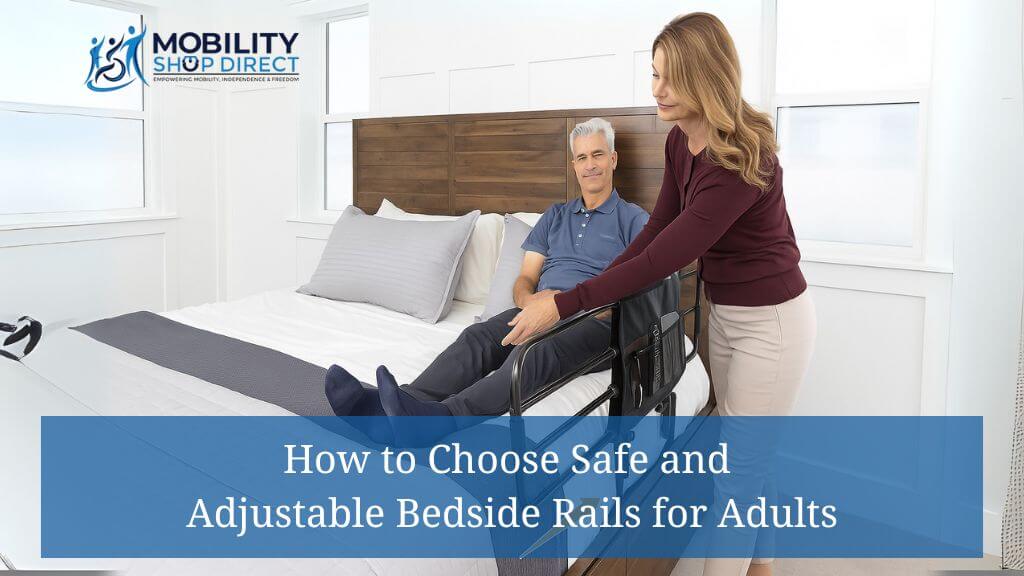If you’re caring for someone with limited mobility or if you’re planning ahead for your own safety there’s one simple piece of equipment that can make a big difference: a bedside rail. But choosing the wrong one? That can do more harm than good. Falls, gaps between the mattress and rail, rails that tip under pressure. These aren’t just frustrating, they’re dangerous.
Whether you're supporting an aging parent, recovering from surgery, or just trying to sleep easier at night, the right bedside rail offers security you can rely on. In this guide, we’ll break down exactly what to look for: from weight capacity and adjustability to bed compatibility and real-world safety features. No fluff. Just what you need to make a smart, safe choice.
Let’s get into it.
Table of Contents
- Understanding the Risks of Unsafe Rails
- Features That Enhance Safety
- Evaluating Stability and Weight Capacity
- Compatibility with Different Bed Types
- Adjustability: A Must-Have Feature for User Comfort
- Easy Installation and User-Friendly Design
- Recommended Safety Standards and Certifications to Look For
- Frequently Asked Questions About Choosing Bedside Rails
- Making the Right Choice: Balancing Safety, Compatibility, and Ease of Use
- Key Takeaways
- Conclusion
Understanding the Risks of Unsafe Rails
Choosing the wrong bedside rails for adults isn’t just inconvenient. It can lead to real safety problems. Falls caused by loose or flimsy rails, or worse, entrapment between the rail and the mattress, are more common than you might think.
This is especially dangerous for seniors or anyone with limited mobility. A poorly fitted rail can actually make things worse, increasing the chance of injury and making everyday movement harder. It’s important to get ahead of these risks by choosing a design that’s made to keep people safe.
Features That Enhance Safety
Not all bedside rails are built the same. When choosing one, look for models that meet Australian safety standards or have been independently tested to reduce risks like tipping, slipping, or entrapment.
Helpful features to look out for include non-slip grips and padded handles, especially important for people with arthritis or limited strength. If someone is using the rail to get in and out of bed, it needs to be both sturdy and easy to grip.
Most importantly, the rail must stay secure under pressure. A wobbly rail can increase the risk of falls. Look for products made from strong, durable materials that anchor firmly to the bed frame or sit solidly between the mattress and base.
Evaluating Stability and Weight Capacity
Why Stability Matters
Stability is key. A good rail doesn’t shift when someone grabs or leans on it. Whether the user is sitting up, adjusting position, or getting out of bed, the rail should stay put.
Imagine someone recovering from surgery relying on a rail to stand, only for it to tip. That’s exactly what you want to avoid. Strong, well-secured rails reduce anxiety and improve safety.
How to Assess Weight Capacity
Most bedside rails support between 110 and 180 kilograms, but it’s always smart to choose one with a higher weight limit than you think you’ll need. That extra strength adds long-term reliability..
Factor in not just body weight, but the added force of pushing or pulling during movement. To avoid accidents, make sure the weight limit comfortably exceeds the user’s actual needs.
For more guidance, this post explains how to choose safe and adjustable bedside rails based on individual needs.
Compatibility with Different Bed Types
Types of Beds and Their Compatibility Considerations
Not every rail works with every bed. Adjustable beds, for example, need rails that move with the bed’s frame. Platform beds or thick mattresses can create gaps that make some rails less effective or even dangerous.
Measuring your mattress and frame combo is essential. A bad fit means less stability and a higher risk of injury.
How to Identify Compatible Rails
Always check product specs and user reviews. Some rails slide between the mattress and frame, others attach with brackets or straps. If you’re unsure, reach out to the manufacturer for confirmation.
It’s a good idea to read this breakdown on bedside rail compatibility before buying.
Adjustability: A Must-Have Feature for User Comfort
Benefits of Adjustable Bedside Rails
Adjustable rails let users pick the height and length that work best for them. Someone recovering from surgery might need a tall, supportive rail at first, and a shorter one later as they heal.
Ideal Adjustable Features for Different Users
Long-term users might want rails that fold down or extend. For others, especially younger people with short-term injuries, height-only adjustment is often enough.
Learn more about matching the right features to user needs in this post on types of bedside rails and their benefits.
Easy Installation and User-Friendly Design
Why Installation Matters
In situations where time matters, like after an unexpected fall or injury, the last thing you need is a rail that’s complicated to assemble. That’s where tool-free designs come in handy.
Portable or detachable rails are also helpful for users who sleep in different locations.
Features to Look for in Installation
Look for rails with clear instructions, lightweight construction, and foldable designs. These features make daily use simpler and allow fast setup or adjustments when needed.
Recommended Safety Standards and Certifications to Look For
What Are Safety Standards for Bedside Rails?
In Australia, bedside rails intended for medical purposes are regulated by the Therapeutic Goods Administration (TGA). Such products must be included in the Australian Register of Therapeutic Goods (ARTG) before they can be legally supplied. This inclusion confirms that the product meets specific safety and performance standards set by the TGA.
Why TGA-Approved Products Are Worth the Investment
While TGA-approved products might come at a higher price point, they offer assurance of safety and reliability. These products have undergone rigorous assessment to ensure they meet the necessary standards for medical devices in Australia. Investing in such certified equipment can provide peace of mind, knowing that the product is less likely to fail and is designed to offer long-term support.
This post also covers the different types of bedside rails and what safety tips to follow when installing them.
Frequently Asked Questions About Choosing Bedside Rails
Are Bed Rails Safe for Elderly with Dementia?
It depends. While rails prevent falls for most, someone with dementia might try to climb over or through them. In those cases, alternatives like safety mats or alarms may be safer.
How Much Weight Can Bed Rails Support?
Most models support 110-180kg. But always check the specs and aim for extra capacity to be safe.
What Size Bed Rail Do I Need?
That depends on your bed size, mattress height, and how much support the user needs. Adjustable models are a good bet if things might change over time.
Making the Right Choice: Balancing Safety, Compatibility, and Ease of Use
- Prioritise Safety: Choose rails with solid certification and anti-slip grips.
- Check Compatibility: Measure your bed and mattress carefully.
- Focus on Adjustability: Pick features that suit both current and future needs.
- Opt for Easy Installation: Quick setups help caregivers save time and stress.
Key Takeaways
- Safety and weight capacity come first.
- Not all rails fit every bed. Compatibility matters.
- Adjustable rails give flexibility for changing needs.
- Certification means the product has been tested for real-world use.
- Easy installation helps everyone involved.
Conclusion
Choosing the right bedside rail is all about understanding your needs. Look for a rail that offers strong safety features, fits your bed type, and can adapt over time. Make sure it’s certified and simple to install, so you can count on it from day one.
Need help finding the right fit? Browse our range of bedside rails designed to suit different bed styles and mobility needs.
Whether it’s for yourself or someone you care for, a well-chosen rail adds everyday peace of mind and support where it matters most.



